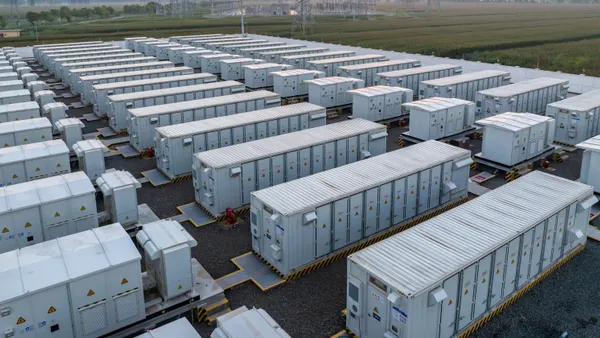Dive Brief:
- American Battery Factory (ABF), a manufacturer incubated from Utah-based energy storage firm Lion Energy, announced plans to deploy a network of battery cell gigafactories to boost U.S. domestic energy storage supply.
- ABF will produce lithium iron phosphate (LFP) batteries for storage suppliers and pack integrators that can be used for utility-scale storage, residential storage and even certain large mobile uses. The company will deploy smaller factories producing between 3 GW and 15 GW of battery cells, which can be installed in a manner of weeks to meet demand.
- The announcement comes as the Biden administration is working to boost the domestic manufacturing industry in order to meet the demand for energy storage products without increasing the country’s reliance on China. “We’re a conduit to really scale and commercialize these cells and bring American innovation to the marketplace,” said ABF President and CEO Paul Charles.
Dive Insight:
A June 2021 Department of Energy (DOE) report found that the U.S. controls less than 10% of the global market share for battery components and cell fabrication, compared to China’s 75% for cell fabrication. At the same time, demand for energy storage battery cells is expected to rise significantly as the grid transitions to renewable energy sources, with the Energy Information Administration projecting 10,000 MW of new storage installed between 2021 and 2023.
Charles said there is potential for the U.S. to “leapfrog into a leadership position” on energy storage, but it will take significant manufacturing development and investment. ABF is an offshoot of Utah-based battery and solar generator company Lion Energy, which had been manufacturing its products in China but wanted to move its cell production in the U.S. Through ABF’s portable factory design, which relies on technology for stand-up shelters and automated processes, the company hopes to build cell manufacturing close to end users to reduce shipping and build larger battery ecosystems.
The company will specialize in prismatic LFP batteries, a variety of lithium-based battery that does not use cobalt and tends to have a lower fire risk than conventional nickel-based batteries. Tesla CEO Elon Musk has said the company is making a “long-term shift” to LFP cells for storage products and some electric vehicles, while Ford and Volkswagen have also said LFP will be used in their electric cars. Although the technology was once thought to have been left behind because of cost, LFP batteries have become more popular for storage, with a 2020 Wood Mackenzie report predicting LFP could overtake nickel-based batteries for storage applications by 2030.
"There is about to be a significant increase in demand for LFP batteries in the U.S. stationary market” and LFP is “quickly turning into the dominant technology in that space,” Sam Jaffe, vice president of battery solutions for the utility solutions firm E Source, said in an email.
According to AFB, the company’s batteries will perform at least 10,000 discharge cycles with a 20-30 year lifespan. The products will be designed for storage systems on the utility- and residential-scale level, as well as military uses and certain large electric vehicles like trucks, buses and trams.
In February, the Biden administration released a supply chain strategy for clean energy products, including batteries, that will incentivize mining, refining and manufacturing. Using funds from the bipartisan infrastructure law, DOE also announced $3 billion in programs for battery production for electric vehicles and energy storage. DOE said in December that there are 13 new EV battery cell gigafactories coming to the U.S. by 2026, including projects by Ford, General Motors and Toyota. Companies like KORE Power have also announced plans to build American gigafactories focused on storage.
Charles said the U.S. has a “massive need” for energy storage and a “responsibility” to build more storage to support the electrification movement.
“As far as we know, this is the first opportunity to make safe cells geared specifically to storage, a story that is becoming more and more popular and relevant,” he said. “Our goal is to grow the U.S. clean energy economy.”














